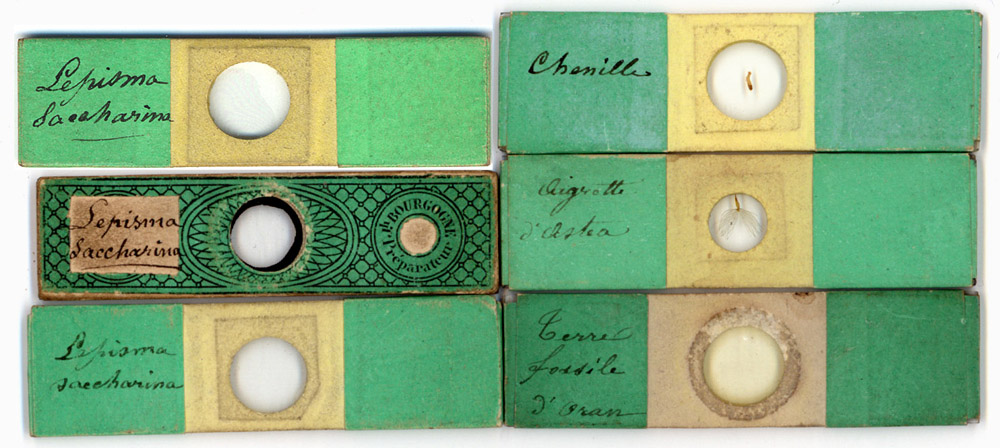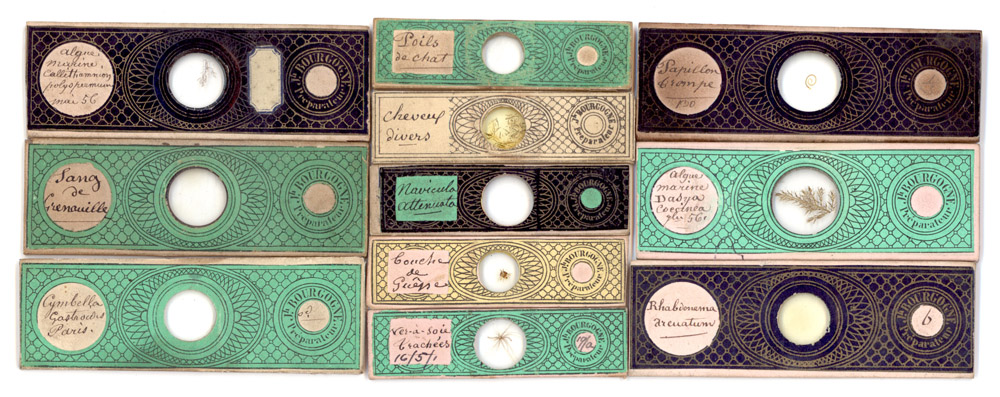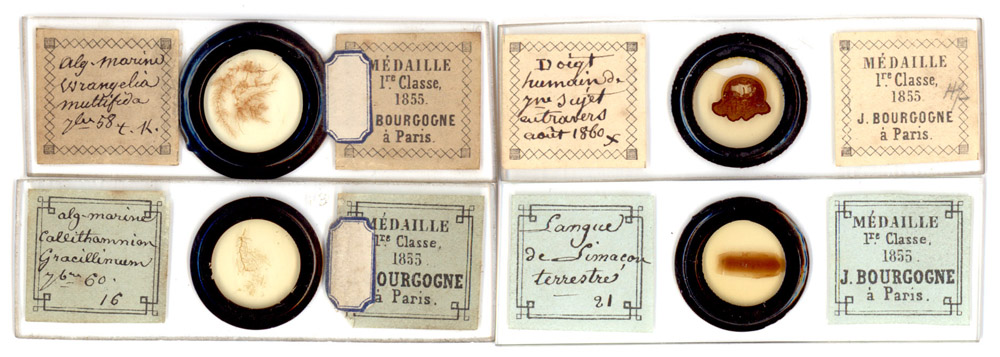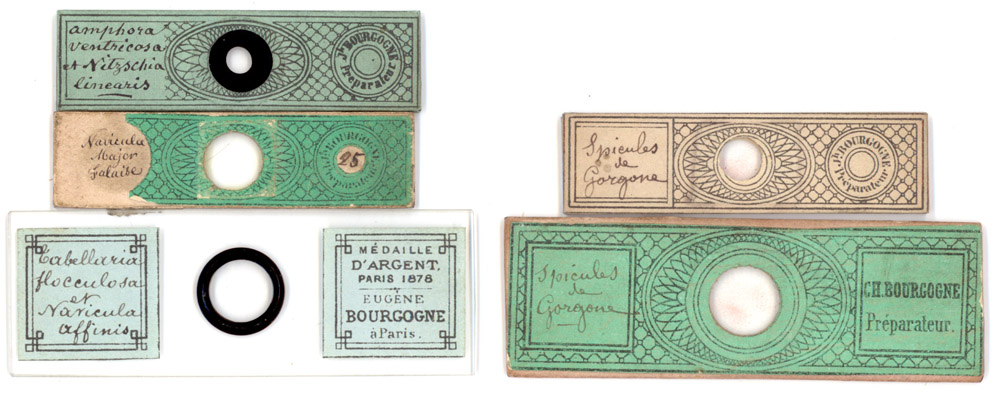

Joseph Bourgogne, microscopist (ca. 1810 – after 1879)
Brian Stevenson, Kentucky, USA
Many of Joseph Bourgogne’s contemporaries considered him to be one of the 19th Century’s most important preparers of microscope slides. His mounts won numerous medals at exhibitions in Paris and London, and were prized by microscopists the world over. He was also credited with discovering the male sarcopid mite of humans. But, as is so often the case, Bourgogne’s fame has diminished over time. When Brian Bracegirdle published his important Microscopical Mounts and Mounters in 1998, he possessed very little information on the Bourgogne family, and Joseph and his sons were not described in any detail. Subsequent publications in the Quekett Journal of Microscopy by Bracegirdle, Stanley Warren, Pierre Girodet and Robert Nuttall have provided some details on Joseph Bourgogne. I have located further information on this important, but so far under-appreciated, microscopist.
Joseph Bourgogne was frequently referred to as “pére” (father), with Charles and Eugene Bourgogne referred to as “fils” (sons). Charles and Eugene worked with Joseph until approximately 1860, when they left him for what appear to be a series of joint and solo microscopy ventures. Vital statistics for early 1800s France are scarce. However, I located birth records for two sons of Joseph Bourgogne and Marie Jeanne Francoise Bertet, with birth dates and locations that coincide with 1891 voter registration records for Charles and Eugene. Charles Bourgogne was born 6 July, 1832, and recorded on 15 July, in La Chapelle district of Paris. Eugene Bourgogne was born 11 October, 1838, and recorded on 12 October, in Paris.

Figure 1. Birth and 1891 voter records of Charles and Eugene Bourgogne, sons of Joseph and Marie Jeanne Francoise Bertet Bourgogne. A. 1832 birth record of Charles Bourgogne. B. 1891 voter record for Charles, with address 16 Bourtebourg. C. 1838 birth record of Eugene Bourgogne. D. 1891 voter record for Eugene, with address 34 rue Cardinal Lemoine.
Microscope slides are known which are labeled “H. Bourgogne.” Addresses and exhibition prizes recorded on the labels of those slides associate them with the Bourgogne brothers, and Eugene specifically. No records of H. Bourgogne have been located. It is unknown whether the mysterious H. was a third brother, or a name adopted for Charles and Eugene’s joint business (see Stevenson, 2009).
Both the catalogue for the 1862 London International Exhibitions and a 1902 description of son Eugene state that Joseph Bourgogne established his microscopy workshop in Paris in 1835. Joseph’s 1862 catalogue stated that he had “twenty-five years of practice.” Charles Robin, in Traité du microscope, described Joseph Bourgogne as having been producing slides since 1825, which may be an error, or may indicate that Bourgogne worked as a slide maker prior to opening his independent shop. Based upon these dates, a reasonable birth date for Joseph Bourgogne is around 1810, contemporary with other significant early slide makers such as Charles M. Topping, Edmund Wheeler, John T. Norman, James W. Bond and John Barnett.
Joseph Bourgogne produced slides both with and without his name attached. His unsigned work may be identified by handwriting comparisons with his labeled slides. Figure 2 illustrates two unsigned microscope slides of Lepisma saccharina scales alongside a J. Bourgogne-labeled slide. A very similar slide, also of Lepisma scales, is illustrated in Bracegirdle’s Microscopical Mounts and Mounters plate 3, slide E. The secondary label of Abraham and Dancer on the Bracegirdle slide dates these slides to 1841-1845. Each slide consists of a 1.6 x 6 cm (5/8 x 2 ¼ inch) plate glass slide with a small, thin cover glass, wrapped in light brown paper with bright green papers at each end. Three other slides with the same handwriting are also illustrated in Figure 2. Microscopical Mounts and Mounters slides 3C and 3D have J. Bourgogne’s handwriting, and are comprised of two plate glass slides held together with balsam and green paper at each end. Due to its similarity with Joseph Bourgogne slides, Microscopical Mounts and Mounters slide 2F was probably made by Bourgogne. Although that slide is labeled with Andrew Pritchard’s name and address, Nuttall reported that Pritchard imported, re-labeled and sold slides made by Joseph Bourgogne. Pritchard also purchased Bourgogne’s slides for his own collection. The two men evidently enjoyed a close, personal relationship, as Pritchard is recorded as having extended invitations to Bourgogne and his family to stay with him while visiting London. These very early Bourgogne slides can frequently be seen for sale today, and are often found accompanying early French drum-style student’s microscopes. Thus, it appears that Joseph Bourgogne quickly established markets through microscope makers on both sides of the Channel.

Figure 2. Microscope slides attributable to Joseph Bourgogne. A third unsigned slide of Lepisma saccharina scales is shown in Brian Bracegirdle’s Microscopical Mounts and Mounters with a secondary label from Abraham and Dancer. That label dates these unsigned slides to the early 1840s. A later, circa 1855 slide bearing J. Bourgogne’s name is shown for handwriting comparison. All are “continental” size, 1.6 x 6 cm (5/8 x 2 ¼ inch).

Figure 3. A variety of microscope slides by Joseph Bourgogne, two of which are dated 1856 in the maker’s hand. All are completely wrapped with paper. Circles or rectangles were cut from the upper papers to reveal a contrasting paper underneath, on which the specimen description was written. This method avoided the possibility of label loss, as could occur if gummed labels were affixed to the slides. Both “continental” (5/8 x 2 ¼ inch, 1.6 x 6 cm) and RMS standard sizes (1 x 3 inches, 2.6 x 8 cm) are shown. In his 1862 catalog, Bourgogne also advertised slides of large specimens that measured 3.6 x 12 cm (1 ½ x 4 inches).
Joseph Bourgogne exhibited his work at shows in France during 1839, 1844 and 1849. He won a prize at the 1851 London International Exposition. His display there was described thusly: “In connection with the microscopes we have noticed, M. Bourgogne exhibits a large collection of microscopical preparations, illustrating the structure of insects, and among them a beautiful dissection of the tracheae of a caterpillar, sections of human and other bones and teeth, and a number of sections of minerals for the polarizing apparatus. All of them are well mounted.” J. Bourgogne was also awarded a 1st Class Medal at the 1855 Paris Universal Exposition. This latter award was heralded on Bourgogne’s late 1850s – early 1860s slides (Figure 4)

Figure 4. Later slides from the Joseph Bourgogne shop, dated 1858 through 1860. The maker’s name labels advertise Bourgogne’s medal from the 1855 Paris Universal Exposition. Bourgogne’s 1862 catalog described slides having this type of label as being his best, first-class mounts. All are “English” standard size slides, 1 x 3 inches (2.6 x 8 cm).
Joseph Bourgogne’s 1862 catalog states that he produced three quality levels of slides. Girodet translated the catalog as describing “cheap preparations of second and third quality levels, to be used with low price microscopes”. Edmund Dixon, in 1857, wrote, “M. Bourgogne's best preparations are excellent, with the merit of being determined and named; his inferior preparations are very indifferent, full of bubbles and dirt. For inspection by persons who have had a certain experience, some of these cheap French preparations are useful; but, as articles of luxury and ornamental art, the English are superior. M. Bourgogne classes his productions into first, second, and third-choice specimens. When Beau Brummel's valet came downstairs from dressing his master for dinner, he generally brought with him an armful of discarded white cravats. ‘These,’ he explained, ‘are our failures.’ Just so we may suppose that M. Bourgogne's third choice preparations—some of them as low as threepence-halfpenny each (what can you expect for threepence-halfpenny?) are, what he is too prudent, as well as too honest, to sell at higher prices; ‘our failures,’ in short. And, as good French preparations are costly, while bad ones are not cheap, an English collector has no motive to go out of his own country, unless perhaps it be for some novelty in the way of morbid anatomy, or other exceptional cases.”
Dixon also wrote, “Amongst continental preparers, Joseph Bourgogne, of Rue Notre-Dame, Paris, stands preeminent. He is a man whose whole soul is in his art, and he naturally speaks of microscopic preparation as one of the most important aids to science. He has had the great advantage of constant communication with the most learned men of Paris, who have aided him in their several departments. From Robin, he has had lessons in anatomy; from Thuret, in the structure of algae. Of late, his health has become impaired in consequence of severe application, while his business is steadily on the increase. He proposes, therefore, to divide his grand microscopic empire into three kingdoms—the mineral, the vegetable, and the animal—one of which he will bequeath to each of his three sons.” This may refer to the enigmatic “H. Bourgogne.” However, Dixon’s essay was obviously cobbled together from various sources, so it is impossible to know if he wrote with any personal knowledge of Bourgogne’s family. It is clear from surviving slides made by Charles and Eugene that there was not a division of subject matter. Moreover, Joseph Bourgogne continued making and selling his slides until at least 1879.
Girodet (2000) reported that Joseph Bourgogne was a major supplier of diatom mounts, and by 1850, was the main source of mounted Pleurosigma angulatum. Bourgogne provided the diatom test slides used in famous resolution studies by van Heurck and by Woodward. An example of Joseph’s devotion to pushing the limits of microscope resolution through diatom observations is provided in an essay by “Rusticus, Jr.” on a microscopist pseudonymed “Pococurante”. The microscopist related that, “we used to have great difficulty in finding good slides. A large part of my time was taken up in ‘hunting’ for them. Many and many a day have I passed with Bourgogne pere in Paris, going over his slides. When searching for tests, I was well rewarded if I found one good one after five or six hours’ examination of a couple of hundred slides. ‘Micro’ was my great rival; he would ‘hunt’ for good slides with all the zeal of a ‘grunter’ after truffles. He was very ardent in affecting exchanges; I have heard him say he has given as many as ten, twenty – aye, forty slides, to obtain one that he coveted. There was one slide in his collection that had ‘given me in the eye;’ it was a colossal Angulatum: the cover-glass was so thick that his lenses couldn’t ‘get at’ it. I don’t care to confess to what baseness or cajolery I resorted to induce him to let me have that slide.”
Several sources credit Joseph Bourgogne with discovering the male of the scabies mite, although there were other claimants to the title of discoverer. Previously, it had been debated whether or not all scabies mites were female, and reproduced asexually. A contemporary wrote, “M. Bourgogne discovered the male of the human itch-insect, which discovery made a great sensation at the time, not having been seen before. It seems to have been completely unknown until 1840, probably because it is never found in the furrows of the skin, as the female always is. Nobody then suspected that the male lived constantly on the surface of the epidermis; being also smaller than the female, it escaped observation. Ten years afterwards, amongst three hundred of these insects, which Monsieur B. had received in several lots, he recognized a single male by its agility, and by its fourth pair of paws, which had suckers at their tips, instead of long bristles, like the female. He valued the precious acarus as a rarity, and it formed part of his collection at the London exhibition in '52. But, Dr. Bourguignon had the indiscretion and the hardihood to publish a pamphlet denying the existence of this male acarus, as well as of the acarus of the rabbit, and others. M. Bourgogne, urged by his friends, started for London, and established the truth of the fact by bringing back the treasured object, and having a drawing made from it, which appeared in the Annales des Maladies de la Peau. And then, visiting the hospital of St. Louis, he captured several males on the skin of patients, in the presence of Dr. Hardy and sundry medical students. The question was of considerable theoretical and physiological importance—touching, as it did, spontaneous generation and the reproduction of parasites in general. M. Bourgogne proved that itch-insects are males and females.” Girodet (2001) translated Bourgogne as stating, “for the male Sarcopte of man, I was the first to discover, in 1840, which remained unknown up to 1851.”
Eugene Bourgogne was reported to have begun working as a “collaborateur” with his father in 1855. Eugene would then have been 17 years old. It is hard to believe that the son would not have assisted with the family business before that age, so 1855 may actually date the completion of Eugene’s apprenticeship and his being taken on as a junior partner. Elder brother Charles probably joined a few years earlier. Handwriting on some slides labeled with Joseph’s name tentatively identify mounts produced by the sons (Figure 5).

Figure 5. Microscope slides labeled Joseph Bourgogne, alongside slides labeled either Eugene or Charles Bourgogne. The handwriting similarities suggest that these J. Bourgogne slides were made by his sons.
The 1862 London Exposition saw separate displays from Joseph Bourgogne and the “Bourgogne Freres” (brothers). Entries in the exposition catalog indicate that E. Bourgogne was the contact person for the Bourgogne Freres, and that the brothers’ workshop was established in 1860. Joseph exhibited “microscopic preparations for the study of anatomy and natural history,” and the Brothers displayed “microscopic preparations of animal and botanical anatomy”. Both workshops received Honourable Mentions in Class XVII – Surgical Instruments for “extensive series of microscopic objects”.
By 1866, the Bourgogne Brothers had established a partnership with a Mr. C. Alliot. The partner has not been conclusively identified, as far as I am aware. Alliot later operated his own operation in Silly en Gouffern, Orne. Bourgogne and Alliot exhibited at the 1867 Paris International Exhibition, and were awarded a Bronze Medal. A correspondent for Hardwicke’s Science-Gossip wrote that “microscopic objects are exhibited … in the French department by Messrs. Bourgogne and Alliot. These require a more careful survey than I have yet been able to make, before any special objects can be indicated. Messrs. Bourgogne’s injections attracted much attention in 1862, but the display here is far inferior in number, though probably fully equal in quality.” This implies that Eugene was part of Bourgogne and Alliot. The partnership exhibited “préparations microscopiques d'objets d'anatomie. Exécution tout à fait remarquable. Les préparations sont parfaitement bien formées. Citons entre autres: des coupes de dents, dans diverses directions, fie l'homme, du cheval, et de divers animaux. Section du système nerveux, coupe d'os. Petits animaux. Préparations botaniques.” Joseph Bourgogne did not present at the 1867 exhibition.
Around this same time, at least one of the Bourgogne sons formed a partnership with Pouilliart. I have not found any further information on Pouilliart.
Eugene Bourgogne was operating a shop under his own name by 1869. A son, Lucien Gustave Eugene Bourgogne, was born that year. By 1872, he was located at 34 rue du Cardinal Lemoine, Paris, and remained in business there until at least 1901. He won a silver medal for his microscopical preparations at the 1878 Paris International Exposition. Eugene was elected as a Corresponding Member of the San Francisco (California) Microscopical Society in 1872.
Charles owned a solo microscopy business at 12 rue Bourtebourg by 1871. Charles’ 1891 voter registration located him at 16 rue Bourtebourg and described him as being a naturalist (Figure 1), so presumably he was still in the microscopy business at that time.
Father Joseph Bourgogne’s business operated at several locations within a small area of Paris. In 1835, he was at 4 rue Massillon. The business was still at the same location in 1858, when it was referred to as being operated by MM. Bourgogne, the plural consistent with a partnership between Joseph and his sons. He remained at that site after the sons left to open their shops at 9 rue de Rennes and 3 rue du Depart. An 1871 text placed Joseph’s shop at 58 rue des Fosses-Saint-Victor. He was at 2 rue Pascal in 1872, and 57 rue Monge in 1876. Between that date and 1878, Joseph left Paris for Merdrignac, in Côtes- du-Nord. He was recorded as then specializing in microscope slides of lichens. I have not found records of Joseph Bourgogne from after 1879, when he would have been approximately 70 years old.
A final word from Dixon to illustrate the esteem in which Joseph Bourgogne was held, “As we treasure cabinet-pictures by Teniers or the Breughels, so shall we set an exalted value on charming bits of still-life from the studios of Amadio or Stevens, on insect-portraits by Topping, on botanical groups by Bourgogne the Elder, and on works by anonymous artists, whose names, though not their productions, still remain unknown to fame.”
Comments
to the author will be welcomed.
Acknowledgements
I am exceedingly grateful to Stanley Warren and Howard Lynk for their encouragement and assistance in preparation of this article.
Resources
Anderson, Thomas M. (1861) On the Parasitic Affections of the Skin, J. Churchill & Sons, London, page 120.
Anonymous (1851) The Great Exposition, The Medical Times, new series 3:387-390.
Anonymous (1859) Notice sur la gale et sur l’animalcule qui la produit, L’Union Médicale 3:313.
Anonymous (1866) Notices to correspondents, Hardwicke’s Science-Gossip 1:96.
Anonymous (1866) Proceedings of societies: the Birmingham Natural History and Microscopical Society, Quarterly Journal of Microscopical Science 6:196.
Anonymous (1872) Proceedings of the San Francisco Microscopical Society, Western Lancet 4:43 and 318.
Anthony, John (1874) The scales of Lepisma as seen with reflected and transmitted light, The Monthly Microscopical Journal, 11:193.
Birth records for Charles and Eugene Bourgogne (1832 and 1838, respectively). Obtained through www.ancestry.fr
Bourgogne, Joseph (1862) Prix Courant des Preparations Microscopiques. I have a copy of this important catalog, made from an original French-language edition in the French National Library, and will provide a pdf to interested readers on request.
Bracegirdle, Brian (1978) A History of Microtechnique, Science Heritage, Lincolnwood, Illinois.
Bracegirdle, Brian (1998) Microscopical Mounts and Mounters, Quekett Microscopical Club, London.
Bracegirdle, Brian and Stanley Warren (2000) Microscopical mounts and mounters: addenda [3], Quekett Journal of Microscopy 38:457-462.
“C. J. B. F.” (1856) Microscopical preparation (query), English Mechanic and World of Science, 26:635.
Catalogue General – Exposition Universelle de 1867, a Paris, (1867) E. Dentu, ed., Classe 12, page 62.
Catalogue Officiel - Exposition Universelle Internationale de 1878, a Paris, tome II, section Francaise, groupes II a VI, Classes 6 a 68, page 97.
Clarke, L. Lane (1870) Objects for the Microscope: Being a Popular Description of the Most Instructive and Beautiful Subjects for Exhibition, 3rd edition, Groombridge and Sons, London, page 202.
Cornu, Alfred (1902) Eugene Bourgogne, L'Industrie Française des Instruments de Précision, 1901-1902.
Dixon, Edmund Saul (1857) Microscopic preparations, originally appearing in Charles Dickens’ Household Words, vol. 16, reprinted in The Living Age, 55:346-352.
Dickerson, Edward A. (1870) Microscopic amplification, Hardwicke’s Science-Gossip, 6:230.
Ellis, Robert (1851) Official Descriptive and Illustrated Catalogue of the Great Exhibition of the Works of Industry of all Nations, Spicer Brothers, London, pages lxxix and cxxvi.
Exposition Universelle de 1862, a Londres, Section Française, Catalogue Officiel (1862) Imprimerie Impériale, Paris, pages 127-128, 242.
Frey, Heinrich, Johann F. Frey, Paul Spillmann (1867) Le Microscope: Manuel à L'usage des Étudiants, pages 223, 250-251.
Girodet, Pierre (2000) Mounters, collectors and sellers of microscopical mounts in France in the 19th and 20th centuries [1] A-L, Quekett Journal of Microscopy, 38:573-592.
Girodet, Pierre (2001) The 1862 Joseph Bourgogne catalogue of microscopical preparations (English translation with notes), Quekett Journal of Microscopy, 39:39-52.
van Heurck, Henri F. (1869) Le Microscope: La Construction, Son Maniement et Son Application aux Études d'Anatomie Végétale, Baillière et fils, Paris, page 200.
Husnot, T. (1879) Nouvelles, Revue Bryologique, no. 4, page 64.
Johnston, Christopher (1858) On a method of preparing and mounting hard tissues for the microscope, American Journal of Science and Arts, Second Series, 25:232-235.
M.C.C. (1867) A voice from Paris, Hardwicke’s Science-Gossip, 2:97-99.
Medals and Honourable Mentions Awarded by the International Juries (1862) Her Majesty's Commissioners, London, page 225.
La médecine a L’Exposition Universelle de 1867, Guide-Catalogue (1867) edited by Germer Baillière, ed., page 18.
Le Moniteur Scientifique (1867) Exposition Universelle de 1867 – Prix et Recompenses, 9:603.
M’Quillen, J.H. (1866) The interglobular spaces in dentine, The Dental Cosmos new series 8:115.
Nuttall, Robert H. (2006) Marketing the achromatic microscope: Andrew Pritchard’s engiscope, Quekett Journal of Microscopy, 40:309-330.
Nylander, M.W. (1878) De theoria algo-lichenica, Revue Internationalle des Sciences, 2:382.
Nylander, M.W. (1878) De theoria algo-lichenica, Association Francaise pour l’Advancement des Sciences, 7th session, pages 705-706.
Pelletan, Jules (1876) Le microscope: Son Emploi et Ses Applications, G. Masson, Paris, pages 60, 153, 177, 180, 188, 219, 239, 256, 279, 313, 330, 364, 526, 572, 557, 578, and 581.
Rapport du Jury Central, Exposition des Produits de L’industrie Francaise (1844), vol. 3, page 725.
Reiche, L. (1856) Communications, Annales de la Societe Entomologique de France, third series, 4:xvi.
Revue des Sciences Naturelles (1872) Boehm, Paris, page 185.
Robin, Charles (1856) Memoire sur les Objets qui Peuvent etre Conserves en Preparations Microscopiques, Bailliere, Paris, page 5.
Robin, Charles (1871) Traité du Microscope, J.B. Baillière, Paris, page 387
Robin, Charles (1877) Traité du microscope et des injections, J.B. Baillière, Paris, pages 302-303.
“Rusticus, Jr.” (1880) Microscopy – past and present, English Mechanic and World of Science, 30:570-571.
Stevenson, Brian (2009) The Bourgogne brothers Eugene and Charles, and the riddle of “H. Bourgogne”, Quekett Journal of Microscopy, 41:63-64.
Voter registration records for Charles, Eugene and Lucien Gustave Eugene Bourgogne (1891). Obtained through www.ancestry.fr
Microscopy UK Front
Page
Micscape
Magazine
Article
Library
Published in the January 2010 edition of Micscape Magazine.
Please report any Web problems or offer general comments to the Micscape Editor .
Micscape is the on-line monthly magazine of the Microscopy UK website at Microscopy-UK .
© Onview.net Ltd, Microscopy-UK, and all contributors 1995 onwards. All rights reserved. Main site is at www.microscopy-uk.org.uk with full mirror at www.microscopy-uk.net .